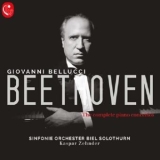 Ludwig van Beethoven: Klavierkonzerte Nr. 1-5; Giovanni Bellucci, Klavier, Sinfonie Orchester Biel Solothurn, Kaspar Zehnder; 5 CDs Calliope CAL 2066; Liveaufnahmen 2015-2018, Veröffentlichung 26/06/2020 (255') - Rezension von Remy Franck
Ludwig van Beethoven: Klavierkonzerte Nr. 1-5; Giovanni Bellucci, Klavier, Sinfonie Orchester Biel Solothurn, Kaspar Zehnder; 5 CDs Calliope CAL 2066; Liveaufnahmen 2015-2018, Veröffentlichung 26/06/2020 (255') - Rezension von Remy Franck
Giovanni Bellucci ist ein außergewöhnlicher Repräsentant der italienischen Klavierschule in der Linie von Busoni, Michelangeli und Pollini. Der Pianist gilt als herausragender Beethoven-Interpret. Dieser Komponist ist mit seinem Werdegang eng verbunden, denn als der Vierzehnjährige zufällig das Klavier und Beethoven entdeckte, brachte er sich zunächst das Klavierspiel selber bei und spielte sofort alle 32 Sonaten von Beethoven, noch ehe er in Rom Musik studierte. Beethoven blieb ein Fixpunkt in seinem Repertoire.
In den fünf Klavierkonzerten fällt sein oft extravagantes Spiel durch eine solide Klanglichkeit, viele Farben, fein elaborierte Nuancen sowie den Gebrauch von viel Rubato auf. Dem Pianist gelingt die Aufwertung auch des scheinbar nebensächlichsten Details. Diese Ausgestaltung zeugt von einem klaren Konzept, das unbeirrbar und konsequent in den fünf Konzerten zur Anwendung gelangt. Dabei halten diese Interpretationen eine durchaus gesunde Mitte zwischen, einerseits, rhythmischer Energie, Spontaneität, Leuchtkraft und Elan, andererseits differenzierter Ausdruckskraft, in der auch das Lyrische (manchmal sehr gedehnt) Platz findet. Belluccis Spiel hat das, was man sich unter beethovenscher Attacke vorstellen kann, auch wenn man ihm einen übermäßigen Gebrauch des Pedals oder auch zu viel Rubato sowie, generell, ein etwas robustes Spiel vorwerfen mag. Belluccis Zyklus, und das ist ein weiterer Vorteil, ist aus einem Guss, auch was das Orchester anbelangt, das eigentlich in allen fünf Konzerten zwar engagiert musiziert aber spieltechnisch manches zu wünschen übrig lässt.
Doch damit nicht genug. Wenn wir diese Gesamtaufnahme empfehlen, dann wegen der Kadenzen. Mit Ausnahme des 5. Klavierkonzerts spielt Bellucci immer mehrere Kadenzen, im ersten Konzert jene von Beethoven, Carl Reinecke und Glenn Gould, im zweiten jene von Beethoven, Bernard Stavenhagen und seine eigenen, im dritten die Kadenzen von Beethoven, Liszt, Brahms und Fauré und im vierten die von Beethoven, Brahms und Busoni.
Der editorische Clou der Calliope-Veröffentlichung liegt darin, dass die Kadenzen jeweils mit der Coda aufgenommen wurde, so dass man auf einem programmierbaren CD-Player jeweils auswählen kann, mit welchen Kadenzen man ein bestimmtes Konzert hören will. Wer also z.B. das 3. Klavierkonzert mit den Kadenzen von Gabriel Fauré hören will, wählt die Tracks 1 für den ersten Satz bis zur Kadenz, dann Track 7 für die Fauré-Kadenz mit Coda und anschließend Track 3 (Largo) und 4 (Rondo). Wer lieber die Brahms-Kadenz hören will, programmiert die Tracks 1,6, 3 und 4.
Giovanni Bellucci is a well-known pianist of the Italian piano school in the line of Busoni, Michelangeli and Pollini. He is considered an outstanding Beethoven interpreter. This composer is closely linked to his career, because when the fourteen-year-old unintentionally discovered the piano and Beethoven, he first taught himself to play the piano and immediately played all 32 Beethoven sonatas, even before he studied music in Rome. Beethoven remained a focus in his repertoire.
In the five piano concertos, his often extravagant playing is impressing with its solid sound, many colours, finely elaborated nuances and the use of much rubato. The pianist succeeds in enhancing even the most seemingly insignificant detail. This concept is consistently applied in the five concertos. At the same time, the interpretations maintain a thoroughly healthy balance between rhythmic energy, spontaneity, luminosity and élan, and, on the other, differentiated expressiveness, in which the lyrical element (sometimes very stretched) also finds its place. Bellucci’s playing has what one can imagine under Beethovenian attack, even if one may accuse him of excessive use of the pedal or too much rubato as well as, in general, a somewhat robust playing. Bellucci’s cycle, and this is a further advantage, is a coherent whole, also with regard to the orchestra, which actually plays with commitment in all five concertos but leaves a lot to be desired in terms of playing technique.
But that is not all. If we recommend this complete recording, it is because of the cadenzas. With the exception of the 5th Piano Concerto, Bellucci always plays several cadenzas, in the first concerto those of Beethoven, Carl Reinecke and Glenn Gould, in the second those of Beethoven, Bernard Stavenhagen and his own, in the third the cadenzas of Beethoven, Liszt, Brahms and Fauré and in the fourth those by Beethoven, Brahms and Busoni.
The highlight of the Calliope publication is that the cadenzas were each recorded with the coda, so that one can select on a programmable CD player with which cadenzas one wants to hear a particular concerto. For example, if you want to hear the 3rd Piano Concerto with the cadenzas by Gabriel Fauré, choose track 1 for the first movement up to the cadenza, then track 7 for the Fauré cadenza with coda, and then track 3 (Largo) and 4 (Rondo). The one who prefers to hear the Brahms cadenza, has to program tracks 1,6, 3 and 4.
























